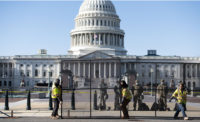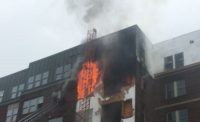Ahead of President-elect Joe Biden’s inauguration, crews erected temporary barriers across the National Mall and repaired temporary stands put in place for the Jan. 20 installation. The added measures were taken after some of President Donald Trump’s supporters stormed the Capitol Building on Jan. 6. Six people died that day or in the aftermath, including two Capitol police officers. More than 100 rioters have been arrested.
Damage from the Jan. 6 riot outlined in an initial report released by the Architect of the Capitol (AOC) includes broken glass and doors as well as graffiti. Pepper spray accretions and residue from tear gas and fire extinguishers also damaged statues, murals, historic benches and original shutters. The report includes two broken 21-ft-tall historic bronze street lamps installed by Frederick Law Olmsted.
A spokeswoman for the AOC says “a more complete assessment” will be completed in the coming months to determine a dollar value of the Jan. 6 damage and how much of the repairs will be contracted out.
The bedlam on Jan. 6 also prompted some pundits and security experts to call for a permanent barricade around the Capitol Building. To date, permanent security measures installed on and around the Capitol are mostly designed to balance safety and accessibility for the compound’s various buildings and grounds.
Beacon for Ideals
“It’s a beacon for the United States, it represents all of our ideals, but at the same time we’re trying to make sure they can continue their function,” says Peggy Van Eepoel, senior principal and a security specialist at Thornton Tomasetti and its Washington, D.C., director.
Van Eepoel—who has worked on several projects within the Capitol compound—could not speak to specific current security measures because of nondisclosure agreements. She did say balancing openness and security is the biggest challenge of working there.
One of the Capitol’s most significant security upgrades, the $600-million Capitol Visitor Center, opened in 2008. The center was designed and constructed so that almost everyone who enters the complex does so about a football field away from the building itself.
Terry Gainer, former chief of the Capitol Police and former Senate sergeant-at-arms, told National Public Radio that in “retrospect,” a fence should have been erected. He added, “We’ve made suggestions from a security point of view that have been rejected.”
Even after the riot, others continue to advocate to support more passive measures. “The fence will take care of it, but the fence is not an appropriate intervention,” a former government employee with knowledge of Capitol security told ENR. “The police have to find other ways, whether it’s increased manpower or portable measures. I’m not quite sure what the solution is, but I know what the solution isn’t.”
The former official called the breach a “real security failure” but said it wasn’t a “physical infrastructure failure.”
Thomas Vonier, a Washington, D.C., and Paris-based architect with experience in building security, agrees. The president of the International Union of Architects and past president of the American Institute of Architects says security measures for government facilities in the U.S. don’t typically “address mob riot scenarios; they aim at deterring vehicle-borne explosives, vehicle ramming attacks, and small-arms attacks by individuals or small paramilitary units.”
In a statement, AOC J. Brett Blanton said, “Now we must continue to meet our mission in the days and months ahead as we support this clean-up and prepare for the upcoming presidential inauguration.”
Longer term, Van Eepoel says all facets of Capitol security will be examined and updated. “It will be an event that will be a reference that we can learn a lot of lessons from.”






Post a comment to this article
Report Abusive Comment